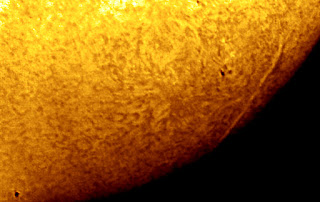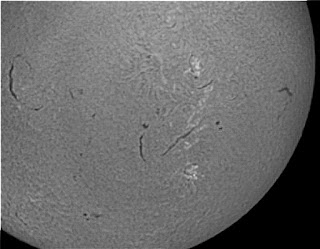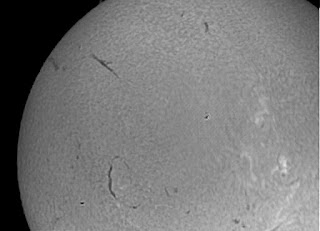The weather forecast for this evening was for heavy cloud and snow. And so, of course, it is clear, cold, and breezy. The day was unremittingly cloudy, but the sun broke through as it began to set. The idea of imaging Mercury again after capturing a fuzzy image of the planet earlier in the week was tempting. But that weather forecast had said cloud and snow, so I stayed put. By 6:45pm, the sky was crystal clear and the sun was below the horizon; I was missing what could be the last opportunity for months to image the planet! I quickly threw the scope and all the gear into the car and drove off to my imaging site.
It was around 30 degrees with a stiff breeze, but I could see Mercury clearly sinking toward the western horizon. One thing I have found is that speed is of the essence when imaging Mercury. The planet is usually low on the horizon when it becomes visible and it sets quickly. I set up, my hands rapidly numbing in the cold (you can't use gloves to set up a scope), and powered up the scope.
I found Mercury, centered it, and replaced the eyepiece with the imager (a modified Lifecam in an eyepiece tube). I had a tough job centering the planet in the field. My ETX has some backlash problems and fine adjustments can be problematic. In addition, I could not precisely polar align (no time and the pole star was not visible), so the planet drifted out of the narrow field of the imager rather quickly. After 3 or 4 minutes, however, I had Mercury centered and roughly stable. I hit the capture button on SmartCap and the program locked up completely. I've never had that happen before, but it locked solid. I had to manually power off the machine and restart it. By the time the laptop came back up, the planet had drifted out of the field and I had to send more time recentering. Focusing was hard with numb fingers and a bouncing scope. The planet was twinkling viciously and the image in the scope was almost formless. For some reason, the adjustment sliders stopped working in SharpCap, so I went ahead and captured a few hundred frames monochrome (SharpCap comes up with the saturation at zero). I restarted SharpCap and then took a couple of sets of color captures. The first showed the pinkish color of the planet well, the second was overexposed, and SharpCap locked up again solidly and I was unable to adjust the image. By this time, Mercury was very low and I decided to hang it up for the evening.



I should also add that the pleasure of the evening was greatly enhanced by juggling reading glasses, eyepieces, imagers and an autostar in a fresh breeze with a wind chill of 18 degrees. I literally could not feel my hands by the time I was done. I post the fuzzy, globby images here as a kind of memorial. I will NEVER image Mercury again, unless it is in tropical climes looking out over a calm, sunset sea and with a suitable libation in hand.


.jpg)















































